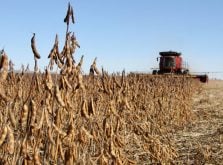James Reimer describes himself as “pretty optimistic” about the outlook for growing crops this year. He’s hopeful that the challenges of last year will not be repeated, especially the excess moisture that saw him harvest only 800 of the 2,400 acres of cropland at his farm.
“It sets you back quite a bit,” said Reimer, who farms northwest of Morris, Man. “I work off the farm so that helps a little bit.”
Excess moisture in Manitoba last year prevented farmers from planting about 1.5 million acres of cropland. Worst hit were farmers in the eastern half of the province.
Read Also

Manitoba extends Crown land rent freeze
Manitoba government links the continued rental rate freeze on grazing and forage leases to economic and environmental challenges facing the industry
Heavy rains during the growing season compounded the challenges, resulting in more than 800,000 acres of seeded cropland being plowed under. Those challenges extended into the western side of the province.
The problems with excess moisture last year will push crop insurance claims to almost $300 million in Manitoba. More than $286 million had already been paid out as of mid-April.
“That’s not all excess moisture, but certainly a good portion is assigned to that,” said Herb Sulkers, vice-president of insurance operations for the Manitoba Agricultural Services Corp.
Andy Nadler, who follows the effects of weather on crops in Manitoba, is encouraged by soil moisture in the province.
Although it was above normal for most areas last fall, winter snowfall was close to normal across southern Manitoba, and farmers generally did not see a lot of rainfall this April.
“There’s been a lot more moisture leaving the soil than coming in,” said Nadler, agriculture meteorologist with Manitoba Agriculture.
“Anything can happen, but things are looking pretty good so far.”
The challenges of last year underlined the need to improve water management in Manitoba. Discussions are under way between the province, Keystone Agricultural Producers and the Association of Manitoba Municipalities.
“We want to get some policies in place that encourage some of the right decisions out there on water storage and drainage,” said KAP vice-president Ian Wishart.
“We don’t expect to fix it in one year. We’ve probably been 30 years getting here, where our drainage system is not functioning as it was intended.”
Doug Chorney farms near East Selkirk, one of the areas confronted with excess moisture in recent years. When interviewed in mid-April, he said the moisture situation in his area looked promising, but local producers are wondering whether to expect a trend toward years of wetter weather. Compounding their worries are the price prospects for crops in 2006.
“Producers often say that when things get back to normal, everything will be OK,” said Chorney. “I’m not hearing that very often anymore. People are starting to think there is no normal.”
During the past 15 years, about $1.1 billion has been paid out through crop insurance in Manitoba, according to Sulkers.
About a third of those payments were due to excess moisture, where crops either couldn’t be planted or were drowned out.














